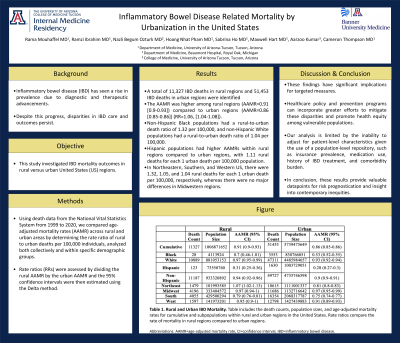Sunday Poster Session
Category: IBD
P0832 - Inflammatory Bowel Disease Mortality: A Cross-Sectional Analysis of Rural and Urban Disparities 1999-2020
Sunday, October 27, 2024
3:30 PM - 7:00 PM ET
Location: Exhibit Hall E

Has Audio

Rama Mouhaffel, MD
Banner - University of Arizona
Tucson, AZ
Presenting Author(s)
Rama Mouhaffel, MD1, Ramzi Ibrahim, MD1, Nazli Begum Ozturk, MD2, Hoang Nhat Pham, MD1, Sabrina Ho, MD1, Maxwell Hart, MD, MEd1, Aarzoo Kumar, BS1, Cameron Thompson, MD1
1Banner - University of Arizona, Tucson, AZ; 2Corewell Health William Beaumont University Hospital, Royal Oak, MI
Introduction: Inflammatory bowel disease (IBD) has seen a rise in prevalence due to diagnostic and therapeutic advancements. Despite this progress, disparities in IBD care and outcomes persist. This study investigated IBD mortality outcomes in rural versus urban United States (US) regions.
Methods: Using death data from the National Vital Statistics System from 1999 to 2020, we compared age-adjusted mortality rates (AAMR) across rural and urban areas by determining the rate ratio of rural to urban deaths per 100,000 individuals, analyzed both collectively and within specific demographic groups. Rate ratios (RRs) were assessed by dividing the rural AAMR by the urban AAMR and the 95% confidence intervals were then estimated using the Delta method.
Results: A total of 11,327 IBD deaths in rural regions and 51,453 IBD deaths in urban regions were identified. However, the AAMR was higher among rural regions (AAMR=0.91 [0.9-0.93]) compared to urban regions (AAMR=0.86 [0.85-0.86]) (RR=1.06, [1.04-1.08]). Non-Hispanic Black populations had a rural-to-urban death ratio of 1.32 per 100,000, and non-Hispanic White populations had a rural-to-urban death ratio of 1.04 per 100,000. Hispanic populations had higher AAMRs within rural regions compared to urban regions, with 1.11 rural deaths for each 1 urban death per 100,000 population. In Northeastern, Southern, and Western US, there were 1.32, 1.05, and 1.04 rural deaths for each 1 urban death per 100,000, respectively, whereas there were no major differences in Midwestern regions.
Discussion: Rural regions have historically been impacted by greater hindrances to appropriate medical care. This includes decreased access to preventative care and primary care physicians, limiting diagnostic capabilities of IBD and therefore may delay diagnosis and worsen outcomes. These findings have significant implications for targeted measures. Healthcare policy and prevention programs can incorporate greater efforts to mitigate these disparities and promote health equity among vulnerable populations. However, our analysis is limited by the inability to adjust for patient-level characteristics given the use of a population-level repository, such as insurance prevalence, medication use, history of IBD treatment, and comorbidity burden. In conclusion, these results provide valuable datapoints for risk prognostication and insight into contemporary inequities.
Note: The table for this abstract can be viewed in the ePoster Gallery section of the ACG 2024 ePoster Site or in The American Journal of Gastroenterology's abstract supplement issue, both of which will be available starting October 27, 2024.
Disclosures:
Rama Mouhaffel, MD1, Ramzi Ibrahim, MD1, Nazli Begum Ozturk, MD2, Hoang Nhat Pham, MD1, Sabrina Ho, MD1, Maxwell Hart, MD, MEd1, Aarzoo Kumar, BS1, Cameron Thompson, MD1. P0832 - Inflammatory Bowel Disease Mortality: A Cross-Sectional Analysis of Rural and Urban Disparities 1999-2020, ACG 2024 Annual Scientific Meeting Abstracts. Philadelphia, PA: American College of Gastroenterology.
1Banner - University of Arizona, Tucson, AZ; 2Corewell Health William Beaumont University Hospital, Royal Oak, MI
Introduction: Inflammatory bowel disease (IBD) has seen a rise in prevalence due to diagnostic and therapeutic advancements. Despite this progress, disparities in IBD care and outcomes persist. This study investigated IBD mortality outcomes in rural versus urban United States (US) regions.
Methods: Using death data from the National Vital Statistics System from 1999 to 2020, we compared age-adjusted mortality rates (AAMR) across rural and urban areas by determining the rate ratio of rural to urban deaths per 100,000 individuals, analyzed both collectively and within specific demographic groups. Rate ratios (RRs) were assessed by dividing the rural AAMR by the urban AAMR and the 95% confidence intervals were then estimated using the Delta method.
Results: A total of 11,327 IBD deaths in rural regions and 51,453 IBD deaths in urban regions were identified. However, the AAMR was higher among rural regions (AAMR=0.91 [0.9-0.93]) compared to urban regions (AAMR=0.86 [0.85-0.86]) (RR=1.06, [1.04-1.08]). Non-Hispanic Black populations had a rural-to-urban death ratio of 1.32 per 100,000, and non-Hispanic White populations had a rural-to-urban death ratio of 1.04 per 100,000. Hispanic populations had higher AAMRs within rural regions compared to urban regions, with 1.11 rural deaths for each 1 urban death per 100,000 population. In Northeastern, Southern, and Western US, there were 1.32, 1.05, and 1.04 rural deaths for each 1 urban death per 100,000, respectively, whereas there were no major differences in Midwestern regions.
Discussion: Rural regions have historically been impacted by greater hindrances to appropriate medical care. This includes decreased access to preventative care and primary care physicians, limiting diagnostic capabilities of IBD and therefore may delay diagnosis and worsen outcomes. These findings have significant implications for targeted measures. Healthcare policy and prevention programs can incorporate greater efforts to mitigate these disparities and promote health equity among vulnerable populations. However, our analysis is limited by the inability to adjust for patient-level characteristics given the use of a population-level repository, such as insurance prevalence, medication use, history of IBD treatment, and comorbidity burden. In conclusion, these results provide valuable datapoints for risk prognostication and insight into contemporary inequities.
Note: The table for this abstract can be viewed in the ePoster Gallery section of the ACG 2024 ePoster Site or in The American Journal of Gastroenterology's abstract supplement issue, both of which will be available starting October 27, 2024.
Disclosures:
Rama Mouhaffel indicated no relevant financial relationships.
Ramzi Ibrahim indicated no relevant financial relationships.
Nazli Begum Ozturk indicated no relevant financial relationships.
Hoang Nhat Pham indicated no relevant financial relationships.
Sabrina Ho indicated no relevant financial relationships.
Maxwell Hart indicated no relevant financial relationships.
Aarzoo Kumar indicated no relevant financial relationships.
Cameron Thompson indicated no relevant financial relationships.
Rama Mouhaffel, MD1, Ramzi Ibrahim, MD1, Nazli Begum Ozturk, MD2, Hoang Nhat Pham, MD1, Sabrina Ho, MD1, Maxwell Hart, MD, MEd1, Aarzoo Kumar, BS1, Cameron Thompson, MD1. P0832 - Inflammatory Bowel Disease Mortality: A Cross-Sectional Analysis of Rural and Urban Disparities 1999-2020, ACG 2024 Annual Scientific Meeting Abstracts. Philadelphia, PA: American College of Gastroenterology.
